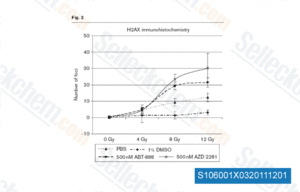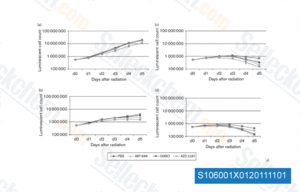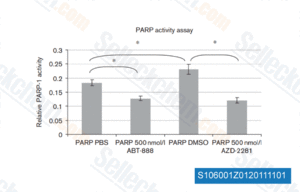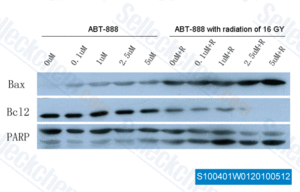|
Toll Free: (877) 796-6397 -- USA and Canada only -- |
Fax: +1-832-582-8590 Orders: +1-832-582-8158 |
Tech Support: +1-832-582-8158 Ext:3 Please provide your Order Number in the email. |
Technical Data
| Formula | C13H16N4O |
|||
| Molecular Weight | 244.29 | CAS No. | 912444-00-9 | |
| Solubility (25°C)* | In vitro | DMSO | 49 mg/mL (200.58 mM) | |
| Water | Insoluble | |||
| Ethanol | Insoluble | |||
|
* <1 mg/ml means slightly soluble or insoluble. * Please note that Selleck tests the solubility of all compounds in-house, and the actual solubility may differ slightly from published values. This is normal and is due to slight batch-to-batch variations. * Room temperature shipping (Stability testing shows this product can be shipped without any cooling measures.) |
||||
Preparing Stock Solutions
Biological Activity
| Description | Veliparib (ABT-888, NSC 737664) is a potent inhibitor of PARP1 and PARP2 with Ki of 5.2 nM and 2.9 nM in cell-free assays, respectively. It is inactive to SIRT2. Veliparib increases autophagy and apoptosis. Phase 3. | ||||
|---|---|---|---|---|---|
| Targets |
|
||||
| In vitro | ABT-888 is inactive to SIRT2 (>5 μM). [1] ABT-888 inhibits the PARP activity with EC50 of 2 nM in C41 cells. [2] ABT-888 could decrease the PAR levels in both irradiated and nonirradiated H460 cells. ABT-888 also reduces clonogenic survival and inhibits DNA repair by PARP-1 inhibition in H460 cells. ABT-888 increases apoptosis and autophagy in H460 cells when combination with radiation. [3] ABT-888 also inhibits PARP activity in H1299, DU145 and 22RV1 cells and the inhibition is independent of p53 function. ABT-888 (10 μM) suppresses the surviving fraction (SF) by 43% in the clonogenic H1299 cells. ABT-888 shows effective radiosensitivity in oxic H1299 cells. Furthermore, ABT-888 could attenuate the SF of hypoxic-irradiated cells including H1299, DU145 and 22RV1. [4] |
||||
| In vivo | The oral bioavailability of ABT-888 is 56%-92% in mice, Sprague-Dawley rats, beagle dogs, and cynomolgus monkeys after oral administration. [1] ABT-888 (25 mg/kg i.p.) could improve tumor growth delay in a NCI-H460 xenograft model with well tolerated. Combination with radiation, ABT-888 decreases the tumor vessel formation. [3] ABT-888 reduces intratumor PAR levels by more than 95% at a dose of 3 and 12.5 mg/kg in A375 and Colo829 xenograft models and the suppression could be maintained over time. [4] |
||||
| Features | Increases the efficacy of common cancer therapies such as radiation and alkylating agents. |
Protocol (from reference)
| Kinase Assay: |
|
|---|---|
| Animal Study: |
|
References
Customer Product Validation

-
Data from [Nucl Med Commun, 2011, 32, 1046-1051]

-
Data from [Nucl Med Commun, 2011, 32(11), 1046-51]

-
Data from [Nucl Med Commun, 2011, 32(11), 1046-51]

-
, , Dr.Zhang of Tianjin Medical University
Selleck's Veliparib (ABT-888) has been cited by 258 publications
| PARP inhibitors differentially regulate immune responses in distinct genetic backgrounds of high-grade serous tubo-ovarian carcinoma models [ Cancer Res Commun, 2025, 10.1158/2767-9764.CRC-24-0515] | PubMed: 39851178 |
| Transcription-replication conflicts underlie sensitivity to PARP inhibitors [ Nature, 2024, 10.1038/s41586-024-07217-2] | PubMed: 38509368 |
| Transcription-replication conflicts underlie sensitivity to PARP inhibitors [ Nature, 2024, 628(8007):433-441] | PubMed: 38509368 |
| Coupling cellular drug-target engagement to downstream pharmacology with CeTEAM [ Nat Commun, 2024, 15(1):10347] | PubMed: 39643609 |
| UBA1 inhibition sensitizes cancer cells to PARP inhibitors [ Cell Rep Med, 2024, 5(12):101834] | PubMed: 39626673 |
| Loss of POLE3-POLE4 unleashes replicative gap accumulation upon treatment with PARP inhibitors [ Cell Rep, 2024, 43(5):114205] | PubMed: 38753485 |
| Schlafen 11 further sensitizes BRCA-deficient cells to PARP inhibitors through single-strand DNA gap accumulation behind replication forks [ Oncogene, 2024, 43(32):2475-2489] | PubMed: 38961202 |
| Aggregability of the SQSTM1/p62-based aggresome-like induced structures determines the sensitivity to parthanatos [ Cell Death Discov, 2024, 10(1):74] | PubMed: 38346947 |
| Positive selection analyses identify a single WWE domain residue that shapes ZAP into a more potent restriction factor against alphaviruses [ PLoS Pathog, 2024, 20(8):e1011836] | PubMed: 39207950 |
| CDK4/6 inhibitors promote PARP1 degradation and synergize with PARP inhibitors in non-small cell lung cancer [ Transl Oncol, 2024, 52:102231] | PubMed: 39662449 |
RETURN POLICY
Selleck Chemical’s Unconditional Return Policy ensures a smooth online shopping experience for our customers. If you are in any way unsatisfied with your purchase, you may return any item(s) within 7 days of receiving it. In the event of product quality issues, either protocol related or product related problems, you may return any item(s) within 365 days from the original purchase date. Please follow the instructions below when returning products.
SHIPPING AND STORAGE
Selleck products are transported at room temperature. If you receive the product at room temperature, please rest assured, the Selleck Quality Inspection Department has conducted experiments to verify that the normal temperature placement of one month will not affect the biological activity of powder products. After collecting, please store the product according to the requirements described in the datasheet. Most Selleck products are stable under the recommended conditions.
NOT FOR HUMAN, VETERINARY DIAGNOSTIC OR THERAPEUTIC USE.
